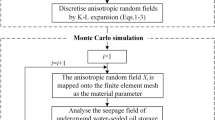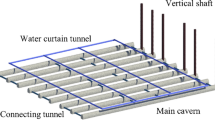Abstract
One of the most important issues in the construction of underground water-sealed oil storage caverns is the assessment of their containment properties. These properties depend on the hydrogeological condition and also engineering characteristics of the caverns. Conceptual hydrogeological model for assessing the containment properties of underground water-sealed oil storage caverns was developed. Empirical, numerical and experimental methods for assessing the containment properties were summarized. A principle for the selection of assessment methods was proposed for engineering application. It was proposed that the selected assessment method should be appropriate for the investigation stages, the research objectives and the parameters which have been determined. A five-stage flowchart for the assessment of containment properties of underground water-sealed oil storage caverns was developed. The set of assessment methods was applied to a pilot underground water-sealed oil storage facility in China. Empirical methods, fracture network method and field test methods were presented for the assessment of the containment properties of the cavern, while the other methods were introduced in previous studies.
Similar content being viewed by others
References
Aberg, B., 1977, Prevention of gas leakage from unlined reservoirs in rock. Proceedings of the 1st International Symposium on Storage in Excavated Rock Caverns, Stockholm, Sept. 5–8, 2, p. 5–8.
Cesano, D., Olofsson, B., and Bagtzoglou, A.C., 2000, Parameter regulating groundwater inflow into hard rock tunnels–a statistical study of the Bolmen tunnel in Southern Sweden. Tunnelling and Underground Space Technology, 15, 153–165.
El Tani, M., 2003, Circular tunnel in a semi-infinite aquifer. Tunnelling and Underground Space Technology, 18, 49–55.
Fernandez, G. and Moon, J., 2010a, Excavation-induced hydraulic conductivity reduction around a tunnel–Part 1: guideline for estimation of groundwater inflow rate. Tunnelling and Underground Space Technology, 25, 560–566.
Fernandez, G. and Moon, J., 2010b, Excavation-induced hydraulic conductivity reduction around a tunnel–Part 2: verification of proposed method using numerical modeling. Tunnelling and Underground Space Technology, 25, 567–574.
Goodall, D.C., Aberg, B., and Breke, T.L. 1988, Fundamentals of gas containment in unlined rock caverns. Rock Mechanics and Rock Engineering, 21, 235–258.
Harr, M.E., 1962, Ground water and seepage. Dover Publications, New York, 336 p.
Kim, J., Cho, W., Chung, I., and Heo, J., 2007, On the stochastic simulation procedure of estimating critical hydraulic gradient for gas storage in unlined rock caverns. Geosciences Journal, 11, 249–258.
Kolymbas, D. and Wagner, P., 2007, Groundwater ingress to tunnels–The exact analytical solution. Tunnelling and Underground Space Technology, 22, 23–27.
Li. S., Wang, Z., Ping, Y., Zhou, Y., and Zhang, L., 2014, Discrete element analysis of hydromechanical behavior of a pilot underground crude oil storage facility in granite in China. Tunnelling and Underground Space Technology, 40, 75–84.
Li, S., Zhang, L., Ma, X., Xue, Y., Wang, Z., Li, Y., Ping, Y., and Jiang, Y., 2013, Space-time evolution behaviour of seepage field around a large underground petroleum storage caverns with groundwater curtaining. Rock and Soil Mechanics, 34, 1979–1986. (in Chinese with English abstract)
Li, Z., Wang, K., Wang, A., and Liu, H., 2009, Experimental study of water curtain performance for gas storage in an underground cavern. Journal Rock Mechanics and Geotechnical Engineering, 1, 89–96.
Lindblom, U., 1989, The development of hydrocarbon storage in hard rock caverns. Proceedings of the international conference on storage of gases in rock caverns, Trondheim, June 26–28, p. 15–30.
Mas Ivars, D., 2006, Water inflow into excavations in fractured rock–a three-dimensional hydro-mechanical numerical study. International Journal of Rock Mechanics and Mining Sciences, 43, 705–725.
Moon, J. and Fernandez, G., 2010, Effect of excavation-induced groundwater level drawdown on tunnel inflow in a jointed rock mass. Engineering Geology, 110, 33–42.
Norwegian Tunnlling Society, 2007, Underground constructions for the Norwegian oil and gas industry, Helli Grafisk As, Oslo, 181 p.
Park, K., Owatsiriwong, A., and Lee, J., 2008, Analytical solution for steady-state groundwater inflow into a drained circular tunnel in a semi-infinite aquifer: A revisit. Tunnelling and Underground Space Technology, 23, 206–209.
Perello, P., Baietto, A., Burger, U., and Skuk, S., 2014, Excavation of the Aica-Mules pilot tunnel for the Brenner base tunnel: information gained on water inflows in tunnels in granitic massifs. Rock Mechanics and Rock Engineering, 47, 1049–1071.
Ping, Y., Wang, Z., Li, S., Xue, Y., and Zhang, L., 2014, Water seal effect evaluation of underground crude oil storage caverns around rock mass with random joints. Rock and Soil Mechanics, 35, 811–819. (in Chinese with English abstract)
Rehbinder, G., Karlsson, R., and Dahlkild, A., 1988, A study of a water curtain around a gas store in rock. Applied Scientific Research, 45, 107–127.
SINOPEC, 2008, Code for design of underground oil storage in rock caverns (GB 50455-2008). China Planning Press, Beijing. (in Chinese)
Sun, J. and Zhao, Z., 2010, Effects of anisotropic permeability of fractured rock masses on underground oil storage caverns. Tunnelling and Underground Space Technology, 25, 629–637.
Wang, Z., Li, S., Liang, J., Qiao, L., Xue, Y., and Zhou, Y., 2014, Prediction and measurement of groundwater flow rate into an underground crude oil storage facility. Chinese Journal of Geotechnical Engineering, 36, 1490–1497. (in Chinese with English abstract)
Wang, Z., Li, S., Qiao, L., and Zhang, Q., 2015a, Finite element analysis of the hydro-mechanical behavior of an underground crude oil storage facility in granite subject to cyclic loading during operation. International Journal of Rock Mechanics and Mining Sciences, 73, 70–81.
Wang, Z., Li, S., and Qiao, L., 2015b, Assessment of hydro-mechanical behavior of a granite rock mass for a pilot underground crude oil storage facility in China. Rock Mechanics and Rock Engineering, 48, 2459–2472.
Wang, Z., Li, S., and Qiao, L., 2015c, Design and test aspects of a water curtain system for underground oil storage caverns in China. Tunnelling and Underground Space Technology, 48, 20–34.
Yu, C., Deng, S., Li, H., Li, J., and Xia, X., 2013, The anisotropic seepage analysis of water-sealed underground oil storage caverns. Tunnelling and Underground Space Technology, 38, 26–37.
Zarei, H.R., Uromeihy, A., and Sharifzadeh, M., 2011, Evaluation of high local groundwater inflow to a rock tunnel by characterization of geological features. Tunnelling and Underground Space Technology, 26, 364–373.
Author information
Authors and Affiliations
Corresponding author
Rights and permissions
About this article
Cite this article
Qiao, L., Wang, Z., Li, S. et al. Assessing containment properties of underground oil storage caverns: methods and a case study. Geosci J 21, 579–593 (2017). https://doi.org/10.1007/s12303-016-0063-4
Received:
Accepted:
Published:
Issue Date:
DOI: https://doi.org/10.1007/s12303-016-0063-4




